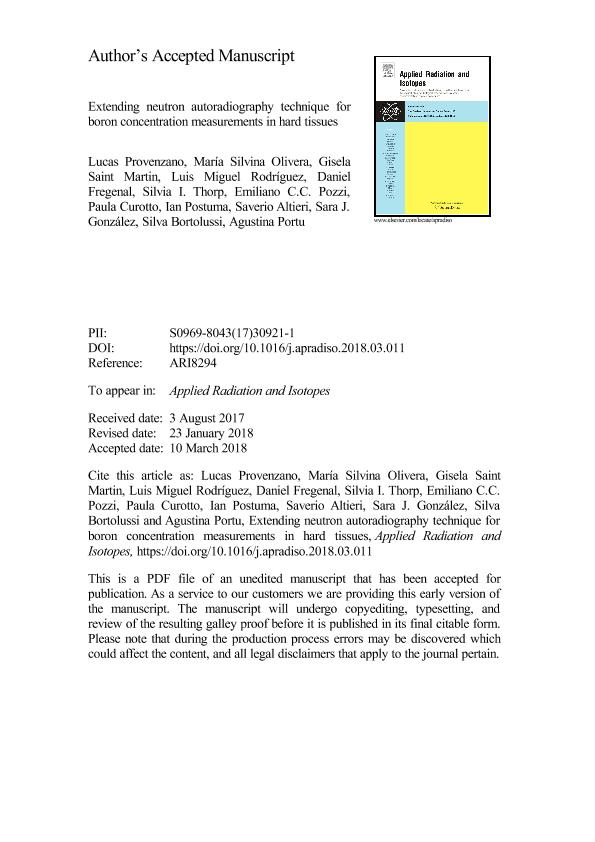Mostrar el registro sencillo del ítem
dc.contributor.author
Provenzano, Lucas

dc.contributor.author
Olivera, María Silvina

dc.contributor.author
Saint Martin, María Laura Gisela

dc.contributor.author
Rodriguez, Luis Miguel

dc.contributor.author
Fregenal, Daniel Eduardo

dc.contributor.author
Thorp, Silvia Inés

dc.contributor.author
Pozzi, Emiliano César Cayetano

dc.contributor.author
Curotto, Paula

dc.contributor.author
Postuma, Ian
dc.contributor.author
Altieri, Saverio
dc.contributor.author
González, Sara Josefina

dc.contributor.author
Bortolussi, Silva

dc.contributor.author
Portu, Agustina Mariana

dc.date.available
2020-08-28T14:36:59Z
dc.date.issued
2018-07
dc.identifier.citation
Provenzano, Lucas; Olivera, María Silvina; Saint Martin, María Laura Gisela; Rodriguez, Luis Miguel; Fregenal, Daniel Eduardo; et al.; Extending neutron autoradiography technique for boron concentration measurements in hard tissues; Pergamon-Elsevier Science Ltd; Applied Radiation and Isotopes; 137; 7-2018; 62-67
dc.identifier.issn
0969-8043
dc.identifier.uri
http://hdl.handle.net/11336/112624
dc.description.abstract
The neutron autoradiography technique using polycarbonate nuclear track detectors (NTD) has been extended to quantify the boron concentration in hard tissues, an application of special interest in Boron Neutron Capture Therapy (BNCT). Chemical and mechanical processing methods to prepare thin tissue sections as required by this technique have been explored. Four different decalcification methods governed by slow and fast kinetics were tested in boron-loaded bones. Due to the significant loss of the boron content, this technique was discarded. On the contrary, mechanical manipulation to obtain bone powder and tissue sections of tens of microns thick proved reproducible and suitable, ensuring a proper conservation of the boron content in the samples. A calibration curve that relates the 10B concentration of a bone sample and the track density in a Lexan NTD is presented. Bone powder embedded in boric acid solution with known boron concentrations between 0 and 100 ppm was used as a standard material. The samples, contained in slim Lexan cases, were exposed to a neutron fluence of 1012 cm−2 at the thermal column central facility of the RA-3 reactor (Argentina). The revealed tracks in the NTD were counted with an image processing software. The effect of track overlapping was studied and corresponding corrections were implemented in the presented calibration curve. Stochastic simulations of the track densities produced by the products of the 10B thermal neutron capture reaction for different boron concentrations in bone were performed and compared with the experimental results. The remarkable agreement between the two curves suggested the suitability of the obtained experimental calibration curve. This neutron autoradiography technique was finally applied to determine the boron concentration in pulverized and compact bone samples coming from a sheep experimental model. The obtained results for both type of samples agreed with boron measurements carried out by ICP-OES within experimental uncertainties. The fact that the histological structure of bone sections remains preserved allows for future boron microdistribution analysis.
dc.format
application/pdf
dc.language.iso
eng
dc.publisher
Pergamon-Elsevier Science Ltd

dc.rights
info:eu-repo/semantics/openAccess
dc.rights.uri
https://creativecommons.org/licenses/by-nc-nd/2.5/ar/
dc.subject
BNCT
dc.subject
BONE
dc.subject
NEUTRON AUTORADIOGRAPHY
dc.subject.classification
Otras Ciencias Físicas

dc.subject.classification
Ciencias Físicas

dc.subject.classification
CIENCIAS NATURALES Y EXACTAS

dc.title
Extending neutron autoradiography technique for boron concentration measurements in hard tissues
dc.type
info:eu-repo/semantics/article
dc.type
info:ar-repo/semantics/artículo
dc.type
info:eu-repo/semantics/publishedVersion
dc.date.updated
2019-10-15T17:54:15Z
dc.journal.volume
137
dc.journal.pagination
62-67
dc.journal.pais
Estados Unidos

dc.description.fil
Fil: Provenzano, Lucas. Consejo Nacional de Investigaciones Científicas y Técnicas; Argentina. Comisión Nacional de Energía Atómica; Argentina
dc.description.fil
Fil: Olivera, María Silvina. Comisión Nacional de Energía Atómica; Argentina
dc.description.fil
Fil: Saint Martin, María Laura Gisela. Comisión Nacional de Energía Atómica; Argentina
dc.description.fil
Fil: Rodriguez, Luis Miguel. Comisión Nacional de Energía Atómica; Argentina. Consejo Nacional de Investigaciones Científicas y Técnicas. Centro Científico Tecnológico Conicet - Patagonia Norte; Argentina
dc.description.fil
Fil: Fregenal, Daniel Eduardo. Consejo Nacional de Investigaciones Científicas y Técnicas; Argentina. Comisión Nacional de Energía Atómica; Argentina
dc.description.fil
Fil: Thorp, Silvia Inés. Comisión Nacional de Energía Atómica; Argentina
dc.description.fil
Fil: Pozzi, Emiliano César Cayetano. Comisión Nacional de Energía Atómica; Argentina
dc.description.fil
Fil: Curotto, Paula. Comisión Nacional de Energía Atómica; Argentina
dc.description.fil
Fil: Postuma, Ian. Istituto Nazionale di Fisica Nucleare; Italia
dc.description.fil
Fil: Altieri, Saverio. Istituto Nazionale di Fisica Nucleare; Italia. Universita Degli Studi Di Pavia; Italia
dc.description.fil
Fil: González, Sara Josefina. Comisión Nacional de Energía Atómica; Argentina. Consejo Nacional de Investigaciones Científicas y Técnicas; Argentina
dc.description.fil
Fil: Bortolussi, Silva. Istituto Nazionale di Fisica Nucleare; Italia. Universita Degli Studi Di Pavia; Italia
dc.description.fil
Fil: Portu, Agustina Mariana. Comisión Nacional de Energía Atómica; Argentina. Consejo Nacional de Investigaciones Científicas y Técnicas; Argentina
dc.journal.title
Applied Radiation and Isotopes

dc.relation.alternativeid
info:eu-repo/semantics/altIdentifier/url/http://linkinghub.elsevier.com/retrieve/pii/S0969804317309211
dc.relation.alternativeid
info:eu-repo/semantics/altIdentifier/doi/http://dx.doi.org/10.1016/j.apradiso.2018.03.011
Archivos asociados
